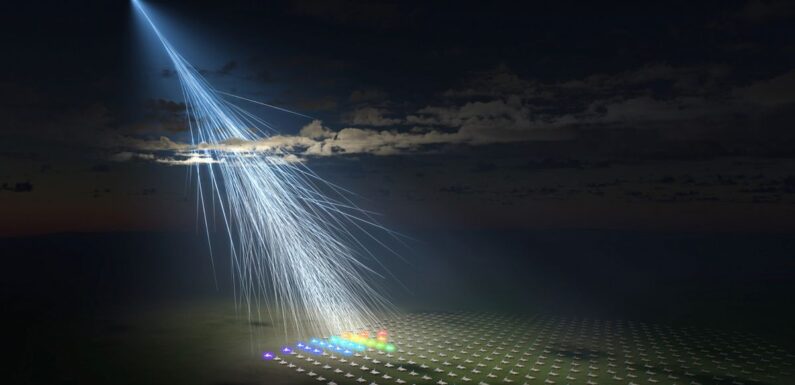
Scientists have discovered one of the most powerful cosmic rays ever – and it’s coming from an unknown part of deep space.
The unusual cosmic occurrence sees energy of 240 quintillion electron volts – that's 240 billion billion or 18 zeros. Experts explained that a traditional lightning bolt is roughly 300 million volts.
The ray, dubbed Amaterasu, might have come from an invisible corridor or "void" in the universe. According to astronomers, cosmic rays are clusters of tiny, high-energy particles that zip through space almost as fast as light.
READ MORE: Aliens and dinosaurs could have roamed Earth together, new research claims
For the latest out of this world news and updates, click here.
They're often detected by instruments on Earth and usually come from solar flares or sun explosions. But scientists reckon Amaterasu must have come from a super-powerful celestial event much bigger than a star explosion.
Professor Toshihiro Fujii of Osaka Metropolitan University in Japan, who observed the phenomenon, told MailOnline: “When I first discovered this ultra-high-energy cosmic ray, I thought there must have been a mistake, as it showed an energy level unprecedented in the last three decades.
"No promising astronomical object matching the direction from which the cosmic ray arrived has been identified, suggesting possibilities of unknown astronomical phenomena and novel physical origins beyond the Standard Mode”.
John Matthews, a research professor at the University of Utah's Department of physics and Astronomy in the US, explained: "Things that people think of as energetic, like supernovas, are nowhere near energetic enough for this. You need huge amounts of energy, really high magnetic fields to confine the particle while it gets accelerated."
The Amaterasu particle, with an energy of 240 quintillion electron volts (EeV), is second only to the Oh-My-God particle, another ultra-high-energy cosmic ray detected in 1991, possessing 320 EeV of energy. When these cosmic rays hit Earth's atmosphere, they cause a cascade of secondary particles and electromagnetic radiation, known as an extensive air shower. Some charged particles in the air shower travel faster than the speed of light, producing a type of electromagnetic radiation that can be detected by specialised instruments.
Join the Daily Star's WhatsApp for the sexiest headlines, showbiz gossip and lots more
The Daily Star is now on WhatsApp and we want you to join us!
Through the app, we'll send you the sassiest showbiz stories, some naught headline and a seismic smattering of aliens…along with the latest breaking news of course.
To join our community, all you have to do to join is click on this link, select 'Join Chat' and you're in!
No one will be able to see who has sign up and no one can send messages except for the Daily Star team. We also treat our community members to competitions, special offers, promotions, and adverts from us and our partners.
If you don’t like our community, you can check out any time you like. To leave our community click on the name at the top of your screen and choose Exit group. If you’re curious, you can read our Privacy Notice.
CLICK HERE TO JOIN
One such instrument is the Telescope Array observatory in Utah, US, which found the Amaterasu particle. This mysterious event appeared to emerge from the Local Void, an empty area of space bordering the Milky Way galaxy. The experts suggest this could indicate a much larger magnetic deflection than predicted, an unidentified source in the Local Void, or an incomplete understanding of high-energy particle physics.
Professor Matthews added: “The particles are so high energy, they shouldn't be affected by galactic and extra-galactic magnetic fields. You should be able to point to where they come from in the sky. But in the case of the Oh-My-God particle and this new particle, you trace its trajectory to its source and there's nothing high energy enough to have produced it. That's the mystery of this what the heck is going on?”.
They hope that the Amaterasu particle will pave the way for further investigations that could help shed light on ultra-high-energy cosmic rays and where they come from.
For the latest breaking news and stories from across the globe from the Daily Star, sign up for our newsletter by clicking here.
John Belz, a professor at the University of Utah's Department of physics and Astronomy, said: “These events seem like they're coming from completely different places in the sky. 'It's not like there's one mysterious source. It could be defects in the structure of spacetime, colliding cosmic strings. I mean, I'm just spit-balling crazy ideas that people are coming up with because there's not a conventional explanation.”
The Telescope Array is a land-based observatory that covers about 700 square kilometres of desert in Utah. UHECRs only fall about once per century per square kilometre, so it takes an instrument this big to detect even one.
The study was published on Thursday in the journal, Science.
Source: Read Full Article


